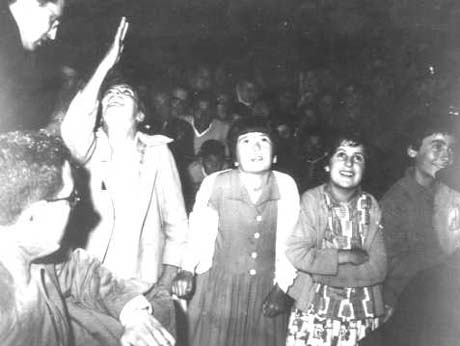The relationship between the apparitions of Garabandal and the mission of evangelization operates on two levels:
Firstly, the content of the core messages attributed to Garabandal – the calls for conversion, penance, prayer, renewed devotion to the Eucharist, and leading good lives – aligns substantially with the fundamental themes and goals of traditional Catholic evangelization. These exhortations, focused on repentance and deepening one’s relationship with God through established means, are doctrinally sound, even if their alleged supernatural origin remains unproven. Secondly, the prophetic elements (Warning, Miracle, and conditional Chastisement) depict a future, divinely initiated, global intervention aimed at achieving mass conversion. In this view, Garabandal foretells an extraordinary, eschatological phase of evangelization orchestrated directly by God.
Examining the substance of the two main messages reveals significant parallels with the core objectives of evangelization:
- Call to Conversion: The explicit and central theme of Garabandal is the urgent call for a “conversion of heart”. This directly mirrors the primary goal of evangelization, which is to bring about metanoia, a fundamental change of mind and heart oriented towards God.
- Emphasis on Penance and Sacrifice: The messages repeatedly stress the need for “much penance” and “many sacrifices”. Within Catholic tradition, penance and sacrifice are understood as essential components of repentance – the turning away from sin and towards God – which is integral to the conversion process sought by evangelization.
- Focus on the Eucharist: Garabandal places strong emphasis on visiting the Blessed Sacrament frequently and laments the diminishing importance given to the Eucharist. This aligns with the Church’s understanding of the Eucharist as the “source and summit of the Christian life,” central to communion with Christ and the life of grace that evangelization aims to foster.
- Concern for the Priesthood: The messages highlight the importance of the priesthood, even while criticizing failures within it. This reflects the essential role of the ordained ministry in the Church’s sacramental life and mission, including preaching and administering the sacraments which are vital channels of grace in the evangelization process.
- Leading Good Lives: The exhortation to “lead good lives” corresponds directly to the call for transformation and authentic Christian witness that is both a fruit and a means of evangelization.
Taken together, the core content of the Garabandal messages promotes themes that are doctrinally orthodox and resonate strongly with the traditional understanding of Catholic life and the objectives of evangelization: repentance, sacramental devotion, moral living, and prayer. This alignment is acknowledged even in official diocesan communications that do not affirm the apparitions’ supernatural origin, noting that the messages “simply repeat the common doctrine of the Church”.
But the messages do not simply reiterate established doctrine; they announce a specific and urgent divine intervention, carrying deep implications for evangelization in today’s world.
- Urgency for Our Times: Garabandal is a critical warning and call from Heaven to avert disaster through repentance.
- Call to Personal Action and Witness: The messages are demanding a personal response of conversion, prayer, and penance. This personal transformation is the necessary foundation for any broader renewal.
- Dramatic Phenomena as Divine Emphasis: The extraordinary phenomena associated with the apparitions are not a mere spectacle, but a divinely intended means to capture attention and underscore the gravity and supernatural origin of the messages, compelling belief in an age of skepticism.
- Source of Hope and Mercy: Despite the stern warnings, Garabandal is also framed by supporters as ultimately a message of hope and Divine Mercy, offering a path back to God. It is often situated within a larger narrative of Marian interventions in modern times (alongside Fatima, Akita, Medjugorje, etc.) aimed at guiding humanity.
- Implicit Call to Evangelize: A crucial element is the second message’s explicit statement that the first message was “not complied with, and as it has not been made known to the world”. This is an implicit mandate for those who do receive the message to actively disseminate it. Sharing the warnings and calls to conversion becomes part of the required response, an act of evangelization driven by urgency and concern for souls.
Garabandal is far more than a historical curiosity; it is a living, urgent summons to profound personal and collective conversion that intrinsically includes the evangelistic task of making the message known. The perceived gravity of the times and the dramatic nature of the reported divine communications serve to amplify this call to action.
The Church’s mission of evangelization endures, rooted in the living proclamation of Jesus Christ as handed down through Scripture and Tradition, and expressed in the sacramental life and faithful witness of the People of God. The continued fascination with Garabandal reveals a deep spiritual thirst and an urgent desire for unmistakable signs of divine guidance amid the confusion and moral ambiguity of our age. At its heart, Garabandal echoes the Gospel’s perennial call: a summons to ongoing conversion and to active participation in Christ’s mission. This call is not separate from the Church but flows through her, drawing souls to Christ through the means of grace she alone offers.
Pierre-Alain Giffard
Email: pierre.alain.giffard@gmail.com
Book on parish revitalization and gowth:
- BOOK – Revive and Thrive: Transforming Parishes into Mission Driven Communities provides a blueprint to breathe new life into parish communities and engage in the core principles of evangelization and disciple-making.
Articles on evangelization and parish revitalization:
- The Apparitions of Garabandal: Messages and Relation to Evangelization (Part 3 – The Prophetic Announcements)
- The Apparitions of Garabandal: Messages and Relation to Evangelization (Part 2 – The Core Messages)
- The Apparitions of Garabandal: Messages and Relation to Evangelization (Part 1 – The Phenomenon)
- Embracing failure: When Hopes Are Shaken, A New Path Is Taken
- Abide, Be Transformed, Be Sent
- Those Who Understand the Heart of Jesus Will Engage in Evangelization
- Understanding the Charismatic Renewal within Catholic Theology
- Evangelization: A Call to Live the Gospel
- A Self-Assessment Tool for Discerning Your Evangelization Style
- Discerning Your Role in Evangelization and Renewal
- Following Christ: A Blessing or a Burden?
- A Prayer for God’s Miracles in Every Situation
- Visions, Prophecies, and Divine Messages: A Call for Discernment
- Key Takeaways for Evangelization
- Grace and Common Sense
- The Message of Jesus: An Invitation to New Life
- Planting Seeds of Faith and Hope
- Go Forth with Joy: Faith That Inspires
- A Virtuous Circle of Evangelization
- The concept of the “Good News”
- Love as the Heart of Church Life and Mission
- The Spirit of Spiritual Conversation: A Path to Transformation
- Prayer for When We Feel Lost
- How to Share Your Faith with Others
- Love and Time
- Evangelization: Sharing the Joy, Peace, and Hope of Christ
- Priestly Leadership in Evangelization
- Café evangelization at the University of Mary Washington
- Evangelization: A Living Testament of God’s Love
- Living in The Joy of The Gospel
- In The Beginning Was the Word: The Primary Role of Scriptures in Evangelization
- One-Phrase Evangelization
- Asking Each Day for the Grace to Help Someone
- The Parish as an Expression of God’s Love for the World
- If no one speaks, no one will know
- Evangelizing Through Healing: Manifesting God’s Loving Presence
- The Parable of the Wise Landowner
- Extraordinary Signs in Extraordinary Times
- The Evangelizing Message of Medjugorje
- The distinction between proselytism and authentic evangelization
- What God Needs from Us Is Love, Reconciliation, and a Spirit of Forgiveness
- Evangelization: A Collaborative Mission of Love
- Prayer and Service that Finds Favor With God
- The Transformative Power of Love
- The Evangelization Power of Prayer and Love for God
- Everyday Evangelization
- Every Act of Love is Evangelization
- Loving Jesus and Making Him Loved
- Embracing a Lifestyle of Worship and Praise
- A Prayer for Divine Healing and Restoration
- Factors That Have Proven to Attract People to Christ
- Evangelization: Finding Life and Giving Life
- The Eucharist: Source And Summit of All Evangelization
- Practical Steps for Reaching the Unchurched
- Bible Sharing Guide for Small Groups: A Synodal Approach
- Bringing People to Christ by Inspiring Love and Praise for God
- Proclaiming God’s Word: A Sacred Call
- From Decline to Renewal: The Transformation of New Life Church–Farmington
- The Church’s Social Doctrine and Evangelization
- Kindness: A Christian Perspective
- How to Bring Someone to Christ
- The Ultimate Purpose of Human Life – Glorifying God
- From Near-Death to New Life: A Rural Church’s Revitalization Journey
- Evangelization simply: “Taste and see that the LORD is good!” (Psalm 34:8)
- Revitalization of Rural Churches
- Attracting Converts to the Catholic Faith
- Addressing Low Attendance in Churches
- Fostering a Sacred Atmosphere during the Sunday Mass
- Prayer to be baptized in the Holy Spirit
- Jesus is Thirsty for Souls
- Praying And Sharing The Good News With God’s Redemptive Names
- Embracing the Call to Evangelize
- What is Most Pleasing to God? Bringing Souls to Christ
- The Growth of the Church of the Nativity (Fr. Michael White)
- Deliverance Prayer, by Fr. Stephen J. Rossetti (AUDIO – mp3)
- The Growth of Saint Benedict Parish (Fr. James Mallon)
- Five Pillars of the Christian Life
- Encountering Christ: The Path to Transformation
- What does it mean to have a personal relationship with Jesus?
- Unleashing The Evangelization Potential of Your Parish
- The Ultimate Goal of Evangelization
- God’s Longing for Love and our Mission to Make it Known
- A prayer for those whom we wish to encounter Christ
- Memorable Sundays
- Fr. Bedard’s Three-Step Blueprint for Evangelisation
- Guide for The Missionary Transformation of Parishes
- Divine Encounters: A Practical Guide for Small Evangelization Groups
- The Missionary Transformation of Sant’Eustorgio Parish
- Creating Vibrant Faith Communities: Insights from ‘Excellent Catholic Parishes’
- Sharing The Gospel According to People’s Needs And Receptivity
- A Prayer for Inviting Others to Evangelization Meetings and Services
- Welcoming Church Guests and Visitors: Dos and Don’ts
- Various Dimensions of Evangelization
- The True Measure of Success
- Pope Francis on Evangelization
- Revitalizing the Rural Parish for Mission
- Factors Leading to Christian Conversion
- Evangelizing Through Random Acts of Kindness
- Questions To Start Spiritual Conversations
- Three Feet From Gold
- Spreading the Gospel One Act at a Time
- Gather, Witness and Invite
- Prayer to Receive the Spiritual Gifts of The Holy Spirit
- The Language of Evangelization
- Key Factors for Parish Growth According to Rich Birch
- How to defeat Satan?
- Bringing Love, Hope and Healing Through the Gospel
- Love: Our Fundamental Vocation
- Touched by the Master
- A Man, a Dog, and the Ultimate Love
- The essence of evangelization: Loving God and our neighbours
- Loving Our Enemies and Reconciling with Others
- A Powerful Prayer for Healing: You Are The LORD Who Heals Me
- Living a Life of Love: Mother Teresa’s Legacy
- Living a Life of Love: Lessons from the New Testament
- In The Shadows Of Darkness, A Powerful Force Is At Work
- 19 Pastoral Orientations for Parish Renewal and Growth
- The Missionary Renewal of Catechesis
- Characteristics of missionary parishes
- Powerful healing prayer attributed to St. Padre Pio
- We are called to share our faith with others
- Should we seek to grow the Church?
- Find a Need and Fill It – Revealing God’s Heart in the Community
- 15 Habits to Evangelize on a Daily Basis
- The Church’s Mission
- Three Barriers to Building An Invitational Culture In Your Parish
- The Relational Evangelizer
- Doing Church at Home
- The Blind Girl
- A Group of Frogs
- The Elephant Rope
- A Shared Faith is a Growing Faith
- In The Shoes Of The Unchurched
- Parish Evangelizing Cells
- Six Unique Features of Missional Parishes
- Steps Towards Becoming A Missional Parish
- What Is Evangelization, And How Should It Be Carried Out?
- Discussion And Self-Assessment Questions For Parish Evangelization
- A Missional Church Is A Church That Prays
- The Jesus Prayer: A Method To Pray At All Times
- What can help children raised Catholic continue practicing the faith as adults?
- An Example of a Missionary Parish: Phoenix First Assembly of God
- Satan’s Tactics
- Learning to Be a Missionary
- When we cry out to God, he answers
- Presence and Proclamation
- Saving those who are lost
- Saint-Nazaire Parish: The story of a missionary transformation
- Small Groups and Evangelization
- Evangelizing By Inviting People To Receive Jesus As Lord And Saviour
- You Will Receive Power…
- Have You Heard About the Law of Three Hearings and Seven Touches?
- Three Habits of a Fruitful Christian Life



